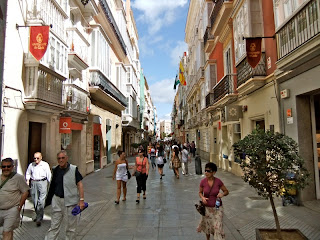Pagosa Springs, CO - U.S.A.
June 14: Here I sit, back home for the the first time in five months, memories of my adventure swirling. Still feeling the movement of the ship, remembering the people I met, friends made, places seen.
As the cruise neared completion, my thoughts shifted from the routine of daily adventure to my upcoming re-entry into the real world. Our last full day was in Le Havre, France, a non-memorable place that French soldiers used as a launch point for raids on England long ago. Officially they were tasked with conquest and plunder, but I suspect they just got bored in Le Havre. Besides, England has always had better pubs.
Was scheduled for a Paris tour today, but decided to skip it. Toured out, didn't want to spend 9 hours on a bus. Will save Paris for a less hurried time. Need a day to reflect on this experience.
For the past five months, the ship has been home. I've gotten to know lots of people here, including many staff. Socializing onboard is effortless. In fact just about everything onboard is effortless. We are pampered, treated nicely. For goodness sake, they even iron our underwear! On the ship, after a while one forgets the day of the week. The standard way to keep track is that on Sundays, caviar is always served during breakfast. So if you see caviar, it must be Sunday. Some abilities atrophy, skills such as driving, cooking, planning, and thinking on one's own. We compensate by learning about new cultures, meeting new people.
On this cruise we stopped in 27 countries - around 66 ports. That leaves much of the planet still to visit, however our sampling provided a good starter kit for gauging societal diversity. Smog-choked cities of 25 million, idyllic villages of 200. Ultra-modern towns striving for the future, tired old cities clinging to the past. Desperate poverty, fabulous wealth. Five months traveling on a ship has been a wonderful experience. And to share that experience with new friends, with adventurous, like-minded souls, has made the sweetest of memories.
The obvious question is whether or not I would do this again, take another world cruise. After several minutes of thoughtful reflection I feel that I would indeed. Perhaps several. Of course I do miss some of the benefits of land travel, especially the ability to stay in an interesting or enjoyable place, to soak up that culture. World cruising never allows that sort of immersion. Yet it's so much fun, it's worth the compromise, at least sometimes.
Do I have any conclusions about our planet? Just this: the world is worth seeing - go check it out.
It's been great fun sharing my travels through this blog. Now that the trip is finished, I say goodbye to those I've met, goodbye to pampered luxury. Hope we'll meet again. And for a while, goodbye to you, my blog audience. Hope you enjoyed my posts, that maybe I sparked interest in a place or two. Au revoir.




















































